Rethinking Sahelanthropus
Posted by: Loren Coleman on March 4th, 2007

As recreations of Sahelanthropus tchadensis demonstrate, this fossil primate may be an ancestor of chimpanzees, gorillas, early humans, and/or even the cryptid agogwe of Africa.
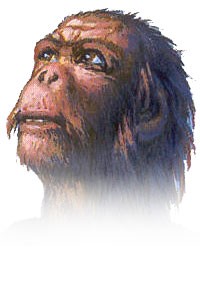
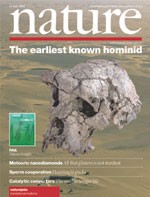
Discovered by Michael Brunet, et.al in Chad, central Africa, about 2,500 km from the East Rift Valley. Reported in the August 15th, 2002 issue of Nature, it is described as being from 6 to 7 million years old.Bone Clones catalogue
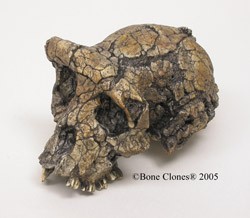
A superbly crafted replica has been produced by the fine folks at Bone Clones. It is actually a work of art, which can be nicely displayed with an inexpensive customized stand, and well worth being in your own personal cabinet of curios or science artifacts at your home, research office, or school. Cryptomundo highly recommends Sahelanthropus tchadensis Skull BH-029. You can order your own directly from Bone Clones.
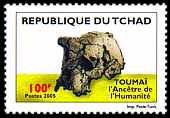
French paleontologist Brigitte Senut (one of the discoverers in 2000 of Orrorin tugenensis, “Millennium Man”) has suggested that Sahelanthropus tchadensis may be an early gorilla.
It is time to reopen the file on this almost-ape, almost-hominid for cryptozoologists. While doing your own research on this new hominoid, hold this skull replica in one hand, and compare it to the Homo floresiensis skull replica in your other one, also from Bone Clones.
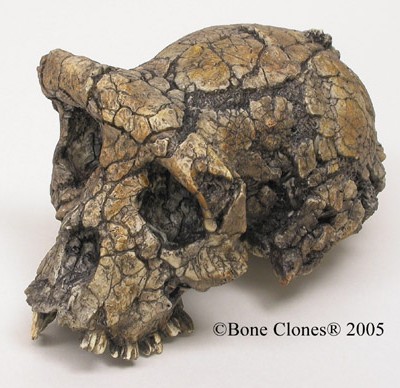
About Loren Coleman
Loren Coleman is one of the world’s leading cryptozoologists, some say “the” leading living cryptozoologist. Certainly, he is acknowledged as the current living American researcher and writer who has most popularized cryptozoology in the late 20th and early 21st centuries.
Starting his fieldwork and investigations in 1960, after traveling and trekking extensively in pursuit of cryptozoological mysteries, Coleman began writing to share his experiences in 1969. An honorary member of Ivan T. Sanderson’s Society for the Investigation of the Unexplained in the 1970s, Coleman has been bestowed with similar honorary memberships of the North Idaho College Cryptozoology Club in 1983, and in subsequent years, that of the British Columbia Scientific Cryptozoology Club, CryptoSafari International, and other international organizations. He was also a Life Member and Benefactor of the International Society of Cryptozoology (now-defunct).
Loren Coleman’s daily blog, as a member of the Cryptomundo Team, served as an ongoing avenue of communication for the ever-growing body of cryptozoo news from 2005 through 2013. He returned as an infrequent contributor beginning Halloween week of 2015.
Coleman is the founder in 2003, and current director of the International Cryptozoology Museum in Portland, Maine.










Looks like he could play football without the helmet. Does anyone know the physiological reason for the heavy bone structure on the brow of most apes and cryptids ?
Joppa-
I beleve it is was the forerunner of the bill of a baseball cap:)
Makes sense to me!
In other words, no one knows.
Interesting, Loren, thanks!
I have even heard theories that the brow ridges were kind of a way to get mates, sort of like a peacock’s tail. Males with stronger brow ridges were seen as more attractive. Not sure how much weight this theory has, though.
@Rillo777 LOL
Does anybody REALLY know what forces were at play and what purpose certain cosmetic features had? Well, if you watch the Discovery Channel an awful lot of people seem to know. They even know what people and animals from thousands of years ago were thinking when they got up in the morning. I find those documentaries terribly entertaining when they start to attribute motivation and thought to relics from days past. I wish more were as honest as Loren, though I imagine that might make for dull viewing as far as television executives are concerned. 😉
I recall reading, a long time ago, about how the idea of brow ridges as buttresses against chewing stresses was tested. Bite pressure was mechanically measured in ape and monkey skulls, then the brow ridge was removed, and the experiment repeated. No significant reduction in bite pressure was found. And among living apes, the Orangutan does not have large brow ridges like the African apes. The brow ridge may help to protect the eyes all right, or it may just “be there”.
I don’t believe that any anatomical feature evolves “in a vacuum”; that is, with one specific “purpose”. I think that Rillo777 is really pretty close to the truth in saying that the brow ridges were “the forerunner of the bill of a baseball cap”.
I think that is reasonable to believe that the brow ridges might provide some relief from the direct glare of the sun, and just possibly providing some protection to the eyes when moving through vegetation. Possibly individuals with heavier brow ridges were more successful at hunting under the hot African sun, where our ancestors first evolved. If so, they may have been able to produce more surviving offspring, and provide more competently for those offspring, than individuals who did not have such heavy brow ridges. So the animals with the heavier brow ridges made more desirable mates. Over time that could have led to heavy brow ridges becoming a trait sought in a mate, which would have in turn led to more animals being born with heavy brow ridges.
As our own species evolved and began to manipulate our environment to suit ourselves, and to invent clothing, most certainly including hats, hoods, and other headgear, brow ridges were no longer a characteristic important to survival, and they began to disappear. But even today, men usually have much heavier browlines than women, and some groups of people have heavy brow ridges (though none have such heavy brow ridges as the African apes).
I may be way off the mark, but it’s a fun topic on which to speculate.
There is the possibility that the brow ridge simply is just there. Not every single feature on an animal has to have evolved to have a purpose. Many animals have features that serve no apparent purpose, but neither do they jeapardize the animal’s ability to survive in its environment. Some things just develop and if they are not a hindrance to the animal, these features just stick around. That may not be the case here, but it is a possibility.
mystery_man: I have frequently used my appendix to shade my eyes from the hot African sun.
Kittenz: I bet your brow ridges are no smaller than mine. But we don’t have to trade photos, at least not here. And yes, I have trouble thinking of someone named kittenz with huge brow ridges. So, wait here, you may have something.
😀
As mystery_man said: mutations happen, all over the map. Some, deleterious, don’t get passed on. Some enhance survival, and do.
Some just happen because, well, individuals that have them continue to breed.
Noticed something else.
The Nature page shown above says “earliest known hominID.”
Isn’t this a hominOID?
A good example of features not needed for survival, yet being passed along anyway, can be seen in vestigial features or organs. Some snakes have small spurs that are what were once legs. These serve no real purpose for them now, yet they persist. Other animals have lost these vestiges in a shorter amount of time. There is a plenitude of animals with these vestigal features, so it demonstrates that it is possible for unneeded appendages or whatnot to be passed on for some time. Granted, these are on their way to being selected out, that is why they are vestigial, but it illustrates my point that not all features are required by an animal to be completely necessary for adapting to the environment.
Authors of the Nature article propose a hominid.
Others have disagreed, saying it is a hominoid.
Still others are more definite that it is a pongid.
I do. I did.
Today’s homiinid?
What’d think, kid?
Tomorrow’s pongid?
Or maybe a giant katydid?
Lorenoid
Well, I have to say that after I saw “Earliest Child” on the cover of National Geographic – over a reconstructed head of what could have been a baby orangutan – I’m not weighing in as an expert.
Pongid.
There. I feel better.
Actually boas’ and pythons’ spurs do have a purpose, mystery_man. They are used during mating. Both males and females have spurs but as a rule the spurs of male snakes are larger and better developed. Each spur has a claw, very similar to the claw of a small dog. The snakes have some control over the claws and can move them.
Features that serve one use can become useful for something entirely different over time, the way snakes’ spurs have done. Characteristics and organs that no longer enhance survival can become vestigal, like the appendices and brow ridges of modern humans.
I disagree that features can evolve for no reason. We don’t always figure out the reasons, and we may very well be wrong about some of those that we think we have figured out, but environmental factors shape all animals.
It’s true that not all features are necessary for survival, but any feature which makes it a bit more likely than an animal will survive, to produce offspring which also survive, is likely to be passed on and become a feature of that species.
Of course, it’s also possible that the ancient females just thought that males with heavy brow ridges were better looking :).
Kittenz- True, we may not always know the reason for a development, but evolution does not always lead to more complex forms. I guess you are right that some of these organs can lead to some different purpose so perhaps my example of snakes was a bad choice. But my point is that not everything that rermains is always useful. If a feature is benign and does not work against the animal in any way and therefore gets passed on, then a feature that serves no purpose can be passed on. The environment does shape the creature but in a way that adapts it to best survive in the environment, these features get passed on because of selective pressures. If there is something that is not impeding that, then there is no particular reason why it should have to dissappear. Evolution does not say “don’t need that” and then get rid of it because it isn’t aesthetically pleasing. I did not say they evolve to be for no reason, but rather if they are just there and never had to be selected out by the environment, and it is not detrimental to the organism in any way, who is to say that it should have dissappeared?
I must add that the brow ridge is such a prominent feature in so many primates and early humans that I doubt this is the case here. It would seem odd for this feature to just happen to “be there” in so many different species. It was just a thought.
Perhaps a better example of a useless vestigial feature is nipples on male mammals.
I agree with what you said, mystery_man, everything that remains is not always useful. But there had to have been some “reason” for the feature to have evolved in the first place.
There are also “reasons” that some things semm to be “aesthetically pleasing”. Many of the reasons are not always readily apparent. We might just think “Wow, (he or she) is nice-looking” – but what is it that makes a human think that another is attractive? Most of the outward signs of “beauty” or “attractiveness” are also indicators of good health – which means that that individual should produce healthy offspring, so “combining genes” might be advantages for the survival of one’s own offspring.
Nothing evolves in a vacuum.
Not neccesarily so, Kittenz. I appreciate your thoughts, but I have to disagree with you there. I will put it another way. Not all features develpo purely due to selection. In a species genome, there will sometimes occur manifestations of certain mutations that are random and occur by statistical chance. This is called genetic drift. It does not require a “reason” as you put it. Sometimes these mutations will be beneficial and will, due to selective pressures, become dominant traits aiding the survival of the species. Others are detrimental, which will obviously fall out of the gene pool. Others are referred to as “nuetral mutations” that have no positive or negative effect on species survival or mortality. In my theory above, the brow ridge could be considered one of these. None of this is happening in a vaccum, mind you, these are random manifestations of traits caused by chance genetic drift. In absense of selective pressures, a species genome undergoes a steady accumulation of these neutral traits. In effect, if this random mutation causes no selective pressure to get rid of it, then it just ends up being “there” and propogates through the genome as any other feature would. Without any particular selective pressure to remove it, it remains. It requires no reason at all, merely that the nuetral genetic mutation not be influenced by selective pressures within the environment.
How’s that for fitting “selective pressure” as many times as possible into a paragraph? 🙂
And I appreciate the thoughts on aesthetics, but that is not what I meant. It was more of a joke that evolution itself doesn’t look at it and think it’s ugly, so I will get rid of it. 🙂
Well, mystery_man:
I don’t think that there’s a selective pressure mechanism that operates through some sort of selective pressure to exert what we might call selective pressure on organisms to adapt according to selective pressure.
I think on a per-word basis I have you beat. It might even make sense if I read it. 😀
But seriously, folks. As I said in a post above, I agree with you. Some things happen and just kind of stay there because nothing selects either for or against them. Can’t it be said that the incredible range of appearance differences among humans exists because our cultural evolution has insulated us from much of the selective pressure other species face?
I count five uses. Pretty good there. 😀
I will even add to my comment above and go as far as to say that it does not even require genetic drift for these neutral mutations to occur. All it needs is a genetic mutation to occur, be that genetic drift, radiation, copy errors during duplication of genetic material, whatever. The point is, this mutation occurs randomly to beging with. It is not until it is subject to the effects of the ecosystem that it is selected for or against. It does not have a purpose or reason to come about in the first place. Normally these random changes to the genome would be shaped by natural selection but nuetral mutations as I have said are not subject to this. They have no reason to be there, yet have no reason to be changed or supressed by any sort of selective pressure and so they remain until that is no longer the case and selection changes them. In this way, there is no need for a reason for the feature to be there, merely that it is not selected against and the feature has a chance to spread through the genome.